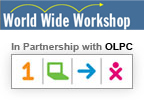Slider Puzzle: Lesson 1: Difference between revisions
Jump to navigation
Jump to search
No edit summary |
No edit summary |
||
| Line 7: | Line 7: | ||
#Take time to illustrate/draw the story that has been told or read. Use whatever you have to draw with -- paper, sand and a stick, or the Paint program on the XO Laptop. Once you have completed your drawings, explain what you have drawn. |
#Take time to illustrate/draw the story that has been told or read. Use whatever you have to draw with -- paper, sand and a stick, or the Paint program on the XO Laptop. Once you have completed your drawings, explain what you have drawn. |
||
#Every story contains these elements: |
#Every story contains these elements: |
||
* |
*Setting (the place where a story happens) |
||
* |
*Characters (the people or creatures in the story) |
||
* |
*Problem (the issue that the characters must face) |
||
* |
*Resolution (how the characters handle the problem, and what happens to them as a result.) |
||
#Identify each of these elements in the story that you just read/told. |
#Identify each of these elements in the story that you just read/told. |
||
#Now Brainstorm a list of interesting settings (i.e. home, the beach, school, church) |
#Now Brainstorm a list of interesting settings (i.e. home, the beach, school, church) |
||
Revision as of 21:31, 18 July 2007
Lesson 1: What is a Story?
- Tell a favorite story to your class. You can also use a picture book if one is accessible.
- Take time to illustrate/draw the story that has been told or read. Use whatever you have to draw with -- paper, sand and a stick, or the Paint program on the XO Laptop. Once you have completed your drawings, explain what you have drawn.
- Every story contains these elements:
- Setting (the place where a story happens)
- Characters (the people or creatures in the story)
- Problem (the issue that the characters must face)
- Resolution (how the characters handle the problem, and what happens to them as a result.)
- Identify each of these elements in the story that you just read/told.
- Now Brainstorm a list of interesting settings (i.e. home, the beach, school, church)
- Brainstorm a list of interesting characters (i.e. princess, monster, child, teacher)
- Brainstorm ideas about problems and resolutions. Think of problems or resolutions that have come up in stories you know, or that have come up in your life or imagination.
- Record all of these ideas to spark your imagination for new stories. Use the Write program on the XO laptop. Create a chart or on poster paper to hang in the classroom.
- Act out a story based on selected story elements. Pick a setting, a few characters, a problem and a resolution from the lists you created. Allow volunteers from the class to act out a story from this. Just make it up as you go along.
